The Sentiero delle Orobie is a captivating hiking trail that winds its way through the dramatic landscapes of the Orobie Alps in Lombardy, Italy. This renowned path connects a network of alpine refuges and bivouacs, offering adventurers an unparalleled experience of the region’s natural beauty, biodiversity, and cultural richness. Divided into two main sections—Occidental and Oriental—the trail is a true paradise for mountain enthusiasts. Whether you’re an experienced trekker or a nature lover seeking shorter excursions, the Sentiero delle Orobie has something for everyone.
The Orobie Path
The Path’s Two Sections
Sentiero delle Orobie Occidentali
This western section of the trail begins in the Stabina Valley and eventually meets the Oriental path at the Rifugio Fratelli Calvi. It offers an array of landscapes, from lush meadows to rugged alpine passes. The refuges along this route provide both rest and a deeper connection to the mountain environment.
- 1st Stage: Cassiglio – Rifugio Cazzaniga-Merlini
Starting in Cassiglio, the trail ascends through forested areas and open meadows, leading hikers to the welcoming Rifugio Cazzaniga-Merlini, perched at the foot of Monte Sodadura. This stage is a perfect introduction to the lush greenery of the Orobie Alps. - 2nd Stage: Rifugio Cazzaniga-Merlini – Rifugio Lecco
This segment takes trekkers over panoramic ridges and past craggy peaks. The journey offers sweeping views of the surrounding valleys, culminating at Rifugio Lecco, renowned for its hearty meals and warm hospitality. - 3rd Stage: Rifugio Lecco – Rifugio Alberto Grassi
A scenic and slightly challenging hike leads to Rifugio Alberto Grassi, which sits on the edge of stunning cliffs and offers breathtaking views of the Orobie range. - 4th Stage: Rifugio Alberto Grassi – Rifugio Cesare Benigni
This stage features serene alpine lakes and dramatic mountain vistas, ending at the charming Rifugio Cesare Benigni, famous for its spectacular sunset views. - 5th Stage: Rifugio Cesare Benigni – Rifugio Cà San Marco
A more moderate hike through gentle inclines, this stage reveals the historic Rifugio Cà San Marco, one of the oldest mountain refuges in the Alps. - 6th Stage: Rifugio Cà San Marco – Foppolo
Hikers traverse through valleys and alpine passes, eventually descending into the ski resort town of Foppolo. The transition from wilderness to civilization is marked by picturesque views. - 7th Stage: Foppolo – Rifugio Fratelli Calvi
The final segment of the western path leads to the Rifugio Fratelli Calvi, located in a picturesque basin surrounded by majestic peaks and pristine alpine lakes.

Sentiero delle Orobie Orientali
The eastern section is renowned for its dramatic landscapes, characterized by rugged peaks and expansive vistas. This path starts in Valcanale and concludes at the Passo della Presolana, offering trekkers a mix of challenging climbs and serene resting points.
- 1st Stage: Valcanale – Rifugio Alpe Corte
Beginning in the verdant Valcanale, the trail gently ascends to Rifugio Alpe Corte, a family-friendly refuge surrounded by tranquil pastures and thick woods. - 2nd Stage: Rifugio Alpe Corte – Rifugio Laghi Gemelli
This segment showcases the beauty of alpine lakes, with the highlight being the sparkling Laghi Gemelli. The refuge offers a cozy retreat with stunning lakefront views. - 3rd Stage: Rifugio Laghi Gemelli – Rifugio Fratelli Calvi
Traversing high-altitude paths, this stage is both challenging and rewarding, with the destination being the picturesque Rifugio Fratelli Calvi. - 4th Stage: Rifugio Fratelli Calvi – Rifugio Baroni al Brunone
A demanding hike with steep ascents and descents, this stage offers striking views of the Orobie giants like Pizzo Coca and Pizzo Redorta. - 5th Stage: Rifugio Baroni al Brunone – Rifugio Coca
Passing through rocky landscapes and high passes, this path ends at Rifugio Coca, nestled in a basin beneath towering peaks. - 6th Stage: Rifugio Coca – Rifugio Antonio Curò
This iconic stage traverses the Circo dei Giganti, an area of breathtaking beauty, culminating at the large and well-equipped Rifugio Antonio Curò. - 7th Stage: Rifugio Antonio Curò – Rifugio Luigi Albani
A more relaxed stage, hikers descend to Rifugio Luigi Albani, which boasts fantastic views of the Presolana range. - 8th Stage: Rifugio Luigi Albani – Passo della Presolana
The final stretch winds through wooded paths and open meadows, concluding at the Passo della Presolana, a celebrated mountain pass with stunning panoramas.

Practical Tips for Enjoying the Sentiero delle Orobie
- Preparation
The Sentiero delle Orobie is a long and demanding trail, so thorough planning is essential. However, the path is flexible, allowing less experienced hikers to tackle smaller segments. For example, choosing to hike from Valcanale to Rifugio Alpe Corte or from Laghi Gemelli to Fratelli Calvi provides an excellent introduction to the alpine experience without the commitment of the full route. - Equipment
Proper gear is vital. Waterproof hiking boots, layered clothing, and trekking poles are must-haves. Bring a reliable map, a GPS device, and a fully charged phone. Don’t forget essentials like sunscreen, a hat, and plenty of water. - Weather Awareness
The mountains are unpredictable. Always check the weather forecast before setting out and be prepared for sudden changes. Avoid hiking during stormy conditions. - Safety
Inform someone of your route and expected return time. Stay on marked paths, and familiarize yourself with emergency procedures. Many refuges have knowledgeable staff who can provide guidance. - Refuges and Accommodations
The refuges along the path offer rest, food, and often breathtaking views. Booking in advance is recommended, especially during peak trekking season. Enjoying local cuisine in these mountain huts is an integral part of the experience.

